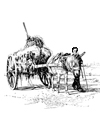 |
1
Prehistoric Times
The first settlers
moved into Ayrshire some 8000 years ago in
the mesolithic period. Evidence of where they
lived and hunted helps us to identify the
routes they may have used. The same applies
to the suceeding Neolithic, Bronze Age and
Celtic peoples. |
|
|
|

|
2
The Roman Period
Although numerous roads have
been proposed for Ayrshire only two have
been proved. This section provides the
background to the Roman invasion of Ayrshire
and an overview of the literature.
|
|
| |
|
|
 |
3
The Dark Ages
A strange mythic period echoing
with the mead-drunken battles of Celtic
warriors as they fought with invading Saxons,
Picts and Scots over the obscure lands of
Aeron. Although no roads were built in this
period the routes reflect the invasion routes
of the time.
|
|
|
 |
4
The Mediaeval Period
David I laid the foundations
of modern Scotland by introducing features
of Norman feudalism to Scotland. He founded
new towns, created shires, and granted lands
to his followers and to the Church. All of
these contributed to the growth of a greatly
expanded road network. |
|
| |
|
|
 |
5
The Post Mediaeval Period
From the 1600's onwards there
was a gradual recognition of the need for
improved roads. This is reflected in the legislation
of the time, particularly the Statute Labour
system that required people to work for six
days without pay and in the work of the Commissioners
of Supply who were responsible for bridges. |
|
|
 |
6
Pre Turnpike Roads
Although our knowledge of Ayrshire
roads in the post-mediaeval period is poor,
there is a compensation at the end of the
period in the maps of the Military Survey
of Scotland, c.1750, which depict all the
roads and tracks in the county. |
|
| |
|
|
 |
7
The Turnpike Era
Turnpike roads were an essential
part of the agricultural and industrial revolutions
that brought so many changes to Scotland.
This section looks at how the turnpikes were
administered in Ayrshire. |
|
|
 |
8
Turnpike Roads
The two main Acts for Ayshire
were passed in 1767 and 1774, allowing Trusts
to be set up and road building to commence.
This section looks at each of these, and later
Acts, and attempts to identify the roads listed
in the Acts. |
|
| |
|
|
 |
9
Local Roads
In addition
to the large number of turnpike roads being
built, each parish had responsibility for
building and maintaining local roads. Details
of each parish are given based on the Statistical
Accounts of Scotland and other sources. |
|
|
 |
10
Coaches and Other Transport
Life on the roads was very
different to what it is now. This section
takes at look at the stagecoaches that ran
on Ayrshire's roads and at the other types
of traffic that would have been encountered. |
|
| |
|
|
 |
11 Turnpike and
Statute Labour Roads in 1859
In 1859, the
Commission for Inquiring into the State of
Public Roads in Scotland carried out a comprehensive
review of roads to see how best the roads
could be funded and managed. The report gives
us a detailed picture of roads in Ayrshire
at that time and what people thought was wrong
with the turnpike system.
|
|
|
 |
12
Ayr County Council - The County Road Board
Apart from a growing reform
movement, competition from the railways led
to a gradual decline in the turnpike system
with loss of revenue and inability to maintain
the roads. In 1883 the turnpike trusts were
disbanded and the roads made the responsibility
of the newly formed County Council under the
County Road Board. |
|
| |
|
|
 |
13
Ayr County Council - The Highways Committee
In 1929, a reorganisation of
local government in Scotland resulted in changes
to the way the roads were administered. This
section details these changes and the work
of the Highways Committee. It also details
new roads that were built in this period and
others that fell out of use. |
|
|
|
